高考英语阅读各题型及解法汇总
- 格式:doc
- 大小:42.50 KB
- 文档页数:4
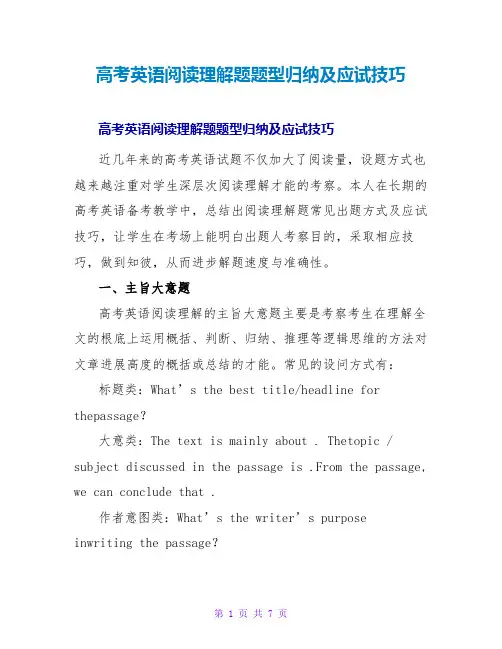
高考英语阅读理解题题型归纳及应试技巧高考英语阅读理解题题型归纳及应试技巧近几年来的高考英语试题不仅加大了阅读量,设题方式也越来越注重对学生深层次阅读理解才能的考察。
本人在长期的高考英语备考教学中,总结出阅读理解题常见出题方式及应试技巧,让学生在考场上能明白出题人考察目的,采取相应技巧,做到知彼,从而进步解题速度与准确性。
一、主旨大意题高考英语阅读理解的主旨大意题主要是考察考生在理解全文的根底上运用概括、判断、归纳、推理等逻辑思维的方法对文章进展高度的概括或总结的才能。
常见的设问方式有:标题类:W hat’s the best title/headline for thepassage?大意类:The text is mainly about . Thetopic / subject discussed in the passage is .From the passage, we can conclude that .作者意图类:What’s the writer’s purposeinwriting the passage?针对主旨大意类型的题,考生可以掌握以下解题策略:把握文章逻辑构造,快速找出主题;寻找主题句,确定文章中心思想;将首段中心句和各段第一句话连接成一个整体,得出文章主题;逆向思维法解标题类问题。
此类题关键在于通读全文,理解作者写作意图,不受干扰项细节影响,要把握好文章的大意,抓住文章的主题句,还应注意文章的体裁及写作目的。
二、数据推断题解答此类题,关键是要擅长捕捉有关数字的信息,然后在透彻理解原文的字面意义和题意的根底上,运用自己的数学知识,分列数字,对其进展分析^p 、推算,从而得出正确的结论。
如阅读理解题:……But now there is a Winter-swimmingEnthusiasts’Club and it has more than 2.000 mem.bers. The oldest is 84 years old and the youngest isonly 7. The members are from all walks oflife ……The question is : Among the winter-swimmersthe oldest is _____ years older than the youngestone.A. 91B. 84 C . 77 D. 7答案是C。
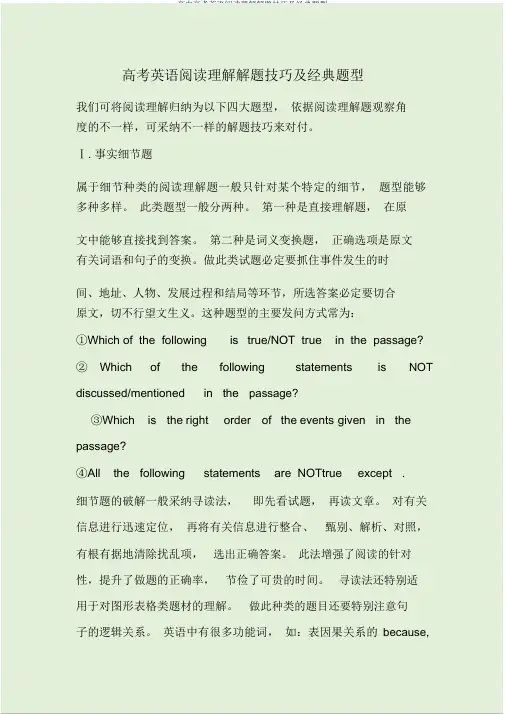
高考英语阅读理解解题技巧及经典题型我们可将阅读理解归纳为以下四大题型,依据阅读理解题观察角度的不一样,可采纳不一样的解题技巧来对付。
Ⅰ.事实细节题属于细节种类的阅读理解题一般只针对某个特定的细节,题型能够多种多样。
此类题型一般分两种。
第一种是直接理解题,在原文中能够直接找到答案。
第二种是词义变换题,正确选项是原文有关词语和句子的变换。
做此类试题必定要抓住事件发生的时间、地址、人物、发展过程和结局等环节,所选答案必定要切合原文,切不行望文生义。
这种题型的主要发问方式常为:①Which of the following is true/NOT true in the passage?②Which of the following statements is NOT discussed/mentioned in the passage?③Which is the right order of the events given in the passage?④All the following statements are NOTtrue except.细节题的破解一般采纳寻读法,即先看试题,再读文章。
对有关信息进行迅速定位,再将有关信息进行整合、甄别、解析、对照,有根有据地清除扰乱项,选出正确答案。
此法增强了阅读的针对性,提升了做题的正确率,节俭了可贵的时间。
寻读法还特别适用于对图形表格类题材的理解。
做此种类的题目还要特别注意句子的逻辑关系。
英语中有很多功能词,如:表因果关系的because,since, as 等;表转折关系的but, however ,on the contrary, on the other hand 等等。
Ⅱ. 猜想词义题在高考阅读题中,考生碰到的最大阻碍常常有两个:一是被已认识的单词的某一熟知含义所误导;二是被完好不认识的单词的意思所阻挡,进而出现理解误差或理解困难,影响阅读的速度。
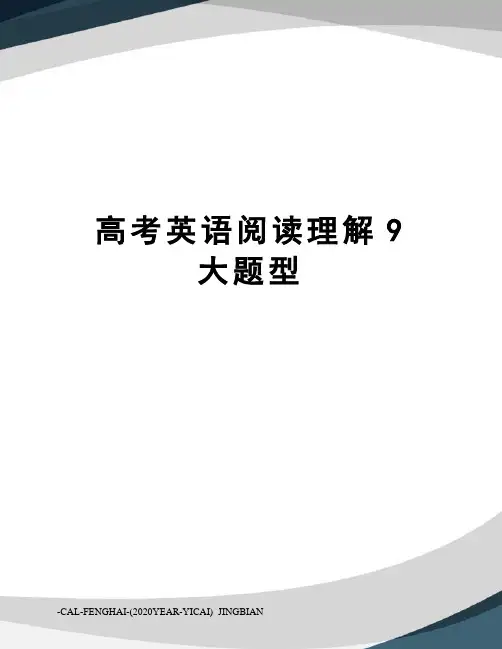
高考英语阅读理解9大题型-CAL-FENGHAI-(2020YEAR-YICAI)_JINGBIAN高考英语阅读理解9大题型+解题技巧英语考的好不好,看阅读理解错几个就知道了。
阅读理解如何快速提升?这几个秘诀帮你助攻↓阅读理解的题型设置要想做好阅读理解题,首先要对阅读理解的题型设置非常熟悉。
阅读理解的题型归纳起来无外乎以下几种。
1.猜测词义常见设题方式为:(1)What does the underlined wordphrase inPara. X probably means according to the passage(2)What does the bold word in the passage refer toetc.2.归纳大意和逻辑推理常见设题方式为:(1)What’s the main idea of the passage(2)What can we learn from the passage(3)What can we infer from the passage3.确定标题常见设题方式为:(1)Which of the following can act as the title of this passage(2)What’s the best title of the passage 4.正误判断常见设题方式为:(1)Which of the following statements is TrueFalse accordingto the passage(2)which of the following statementsis(not)mentioned in thepassage5.事件排序常见设题方式为:(1)Which is the right order of the events mentioned in thepassage6.作者意图或态度常见设题方式为:(1)What’s the author’swriter’sattitude towards somethingaccording to the passage(2)What does the author want to tell us 根据题型找到方法1.例证题①例证题的标记。
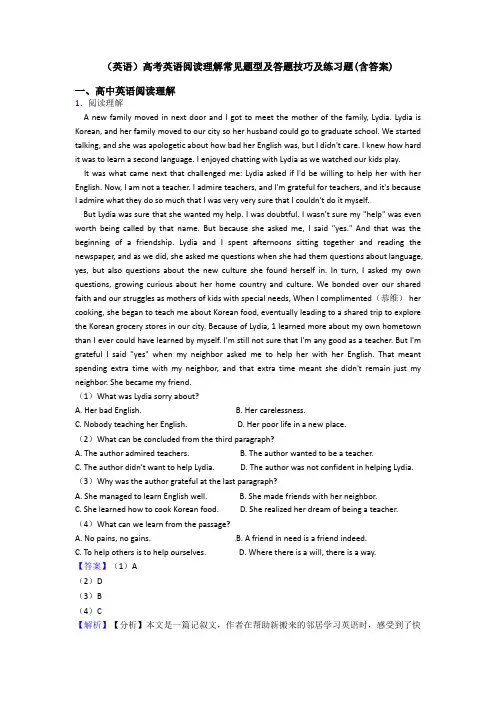
(英语)高考英语阅读理解常见题型及答题技巧及练习题(含答案)一、高中英语阅读理解1.阅读理解A new family moved in next door and I got to meet the mother of the family, Lydia. Lydia is Korean, and her family moved to our city so her husband could go to graduate school. We started talking, and she was apologetic about how bad her English was, but I didn't care. I knew how hard it was to learn a second language. I enjoyed chatting with Lydia as we watched our kids play.It was what came next that challenged me: Lydia asked if I'd be willing to help her with her English. Now, I am not a teacher. I admire teachers, and I'm grateful for teachers, and it's because I admire what they do so much that I was very very sure that I couldn't do it myself.But Lydia was sure that she wanted my help. I was doubtful. I wasn't sure my "help" was even worth being called by that name. But because she asked me, I said "yes." And that was the beginning of a friendship. Lydia and I spent afternoons sitting together and reading the newspaper, and as we did, she asked me questions when she had them questions about language, yes, but also questions about the new culture she found herself in. In turn, I asked my own questions, growing curious about her home country and culture. We bonded over our shared faith and our struggles as mothers of kids with special needs, When I complimented(恭维) her cooking, she began to teach me about Korean food, eventually leading to a shared trip to explore the Korean grocery stores in our city. Because of Lydia, 1 learned more about my own hometown than I ever could have learned by myself. I'm still not sure that I'm any good as a teacher. But I'm grateful I said "yes" when my neighbor asked me to help her with her English. That meant spending extra time with my neighbor, and that extra time meant she didn't remain just my neighbor. She became my friend.(1)What was Lydia sorry about?A. Her bad English.B. Her carelessness.C. Nobody teaching her English.D. Her poor life in a new place.(2)What can be concluded from the third paragraph?A. The author admired teachers.B. The author wanted to be a teacher.C. The author didn't want to help Lydia.D. The author was not confident in helping Lydia.(3)Why was the author grateful at the last paragraph?A. She managed to learn English well.B. She made friends with her neighbor.C. She learned how to cook Korean food.D. She realized her dream of being a teacher.(4)What can we learn from the passage?A. No pains, no gains.B. A friend in need is a friend indeed.C. To help others is to help ourselves.D. Where there is a will, there is a way.【答案】(1)A(2)D(3)B(4)C【解析】【分析】本文是一篇记叙文,作者在帮助新搬来的邻居学习英语时,感受到了快乐和收获,并且和邻居成为了好朋友。
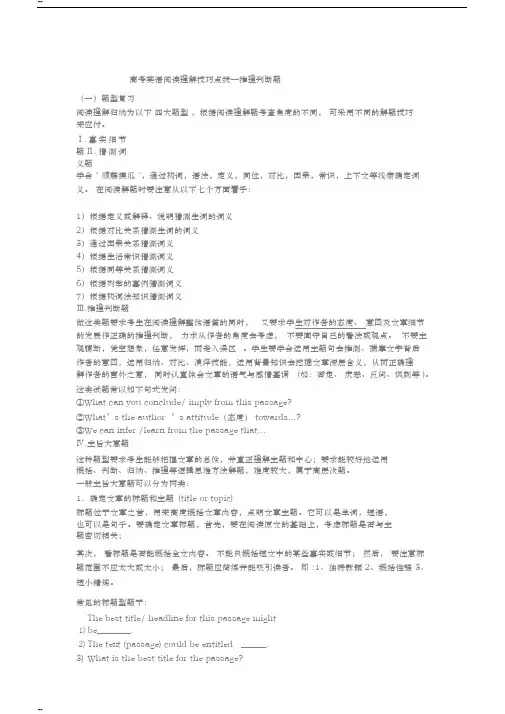
高考英语阅读理解技巧点拨—推理判断题(一)题型复习阅读理解归纳为以下四大题型,根据阅读理解题考查角度的不同,可采用不同的解题技巧来应付。
Ⅰ.事实细节题Ⅱ.猜测词义题学会 " 顺藤摸瓜 ",通过构词,语法,定义,同位,对比,因果,常识,上下文等线索确定词义。
在阅读解题时要注意从以下七个方面着手:1)根据定义或解释、说明猜测生词的词义2)根据对比关系猜测生词的词义3)通过因果关系猜测词义4)根据生活常识猜测词义5)根据同等关系猜测词义6)根据列举的事例猜测词义7)根据构词法知识猜测词义Ⅲ.推理判断题做这类题要求考生在阅读理解整体语篇的同时,又要求学生对作者的态度、意图及文章细节的发展作正确的推理判断,力求从作者的角度去考虑,不要固守自己的看法或观点。
不要主观臆断,凭空想象,任意发挥,而走入误区。
学生要学会运用主题句去推测、揣摩文字背后作者的意图,运用归纳、对比、演绎技能,运用背景知识去挖掘文章深层含义,从而正确理解作者的言外之意,同时认真体会文章的语气与感情基调(如:否定、厌恶、反问、讽刺等 )。
这类试题常以如下句式发问:①What can you conclude/ imply from this passage?②What’s the author ’s attitude(态度) towards...?③We can infer /learn from the passage that...Ⅳ.主旨大意题这种题型要求考生能够把握文章的总体,并真正理解主题和中心;要求能较好地运用概括、判断、归纳、推理等逻辑思维方法解题,难度较大,属于高层次题。
一般主旨大意题可以分为两类:1.确定文章的标题和主题(title or topic)标题位于文章之首,用来高度概括文章内容,点明文章主题。
它可以是单词,短语,也可以是句子。
要确定文章标题,首先,要在阅读原文的基础上,考虑标题是否与主题密切相关;其次,看标题是否能概括全文内容。
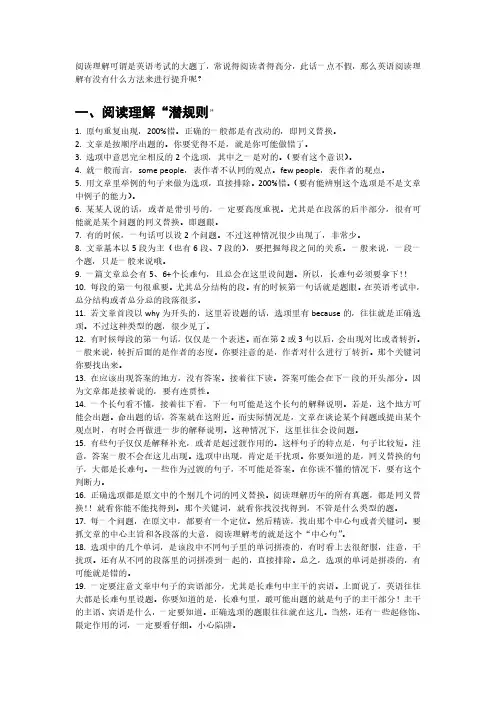
阅读理解可谓是英语考试的大题了,常说得阅读者得高分,此话一点不假,那么英语阅读理解有没有什么方法来进行提升呢?一、阅读理解“潜规则”1.原句重复出现,200%错。
正确的一般都是有改动的,即同义替换。
2.文章是按顺序出题的。
你要觉得不是,就是你可能做错了。
3.选项中意思完全相反的2个选项,其中之一是对的。
(要有这个意识)。
4.就一般而言,some people,表作者不认同的观点。
few people,表作者的观点。
5.用文章里举例的句子来做为选项,直接排除。
200%错。
(要有能辨别这个选项是不是文章中例子的能力)。
6.某某人说的话,或者是带引号的,一定要高度重视。
尤其是在段落的后半部分,很有可能就是某个问题的同义替换。
即题眼。
7.有的时候,一句话可以设2个问题。
不过这种情况很少出现了,非常少。
8.文章基本以5段为主(也有6段、7段的),要把握每段之间的关系。
一般来说,一段一个题,只是一般来说哦。
9.一篇文章总会有5、6+个长难句,且总会在这里设问题。
所以,长难句必须要拿下!!10.每段的第一句很重要。
尤其总分结构的段。
有的时候第一句话就是题眼。
在英语考试中,总分结构或者总分总的段落很多。
11.若文章首段以why为开头的,这里若设题的话,选项里有because的,往往就是正确选项。
不过这种类型的题,很少见了。
12.有时候每段的第一句话,仅仅是一个表述。
而在第2或3句以后,会出现对比或者转折。
一般来说,转折后面的是作者的态度。
你要注意的是,作者对什么进行了转折。
那个关键词你要找出来。
13.在应该出现答案的地方,没有答案。
接着往下读。
答案可能会在下一段的开头部分。
因为文章都是接着说的,要有连贯性。
14.一个长句看不懂,接着往下看,下一句可能是这个长句的解释说明。
若是,这个地方可能会出题。
命出题的话,答案就在这附近。
而实际情况是,文章在谈论某个问题或提出某个观点时,有时会再做进一步的解释说明。
这种情况下,这里往往会设问题。
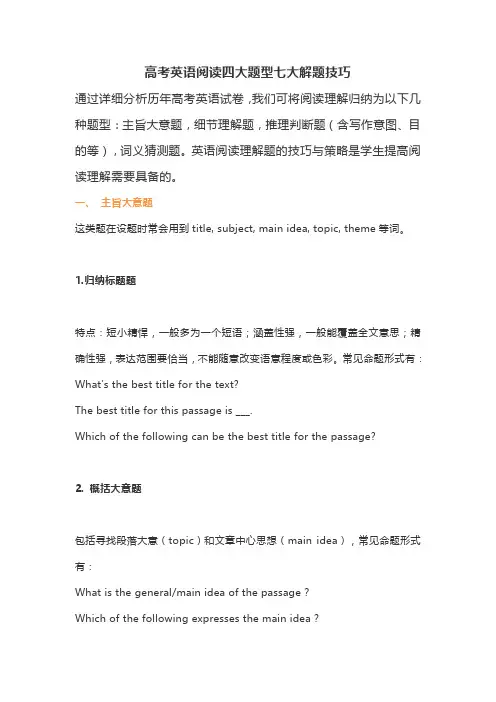
高考英语阅读四大题型七大解题技巧通过详细分析历年高考英语试卷,我们可将阅读理解归纳为以下几种题型:主旨大意题,细节理解题,推理判断题(含写作意图、目的等),词义猜测题。
英语阅读理解题的技巧与策略是学生提高阅读理解需要具备的。
一、主旨大意题这类题在设题时常会用到title, subject, main idea, topic, theme等词。
1.归纳标题题特点:短小精悍,一般多为一个短语;涵盖性强,一般能覆盖全文意思;精确性强,表达范围要恰当,不能随意改变语意程度或色彩。
常见命题形式有:What’s the best title for the text?The best title for this passage is ___.Which of the following can be the best title for the passage?2. 概括大意题包括寻找段落大意(topic)和文章中心思想(main idea),常见命题形式有:What is the general/main idea of the passage?Which of the following expresses the main idea?What is the subject discussed in the text?What’s the article mainly about ?解题技巧阅读理解文章多是议论文和说明文,这两种文体的结构可归纳为:提出问题——论述问题——得出结论或者阐明观点。
对于这类文章,抓主题句是快速掌握文章大意的主要方法。
主题句一般出现在文章的开头或结尾。
主题句具有简洁性、概括性的特点。
主题句在文章中的位置主要有以下几种情况。
位于段首:一般而言,以演绎法撰写的文章,主题句往往在文章的开头,即先点出主题,然后围绕这一主题作具体的陈述。
判断第一句是否为主题句,可具体分析段落的首句与第二,三句的关系;如果从第二句就开始对第一句进行说明,论述或描述,那第一句就是主题句。
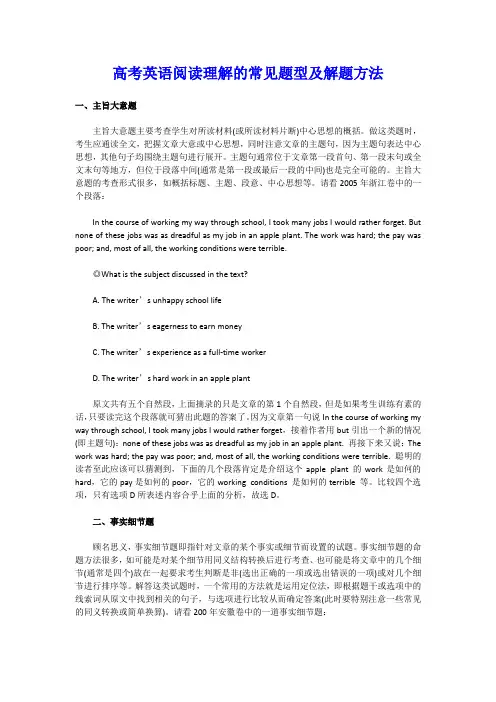
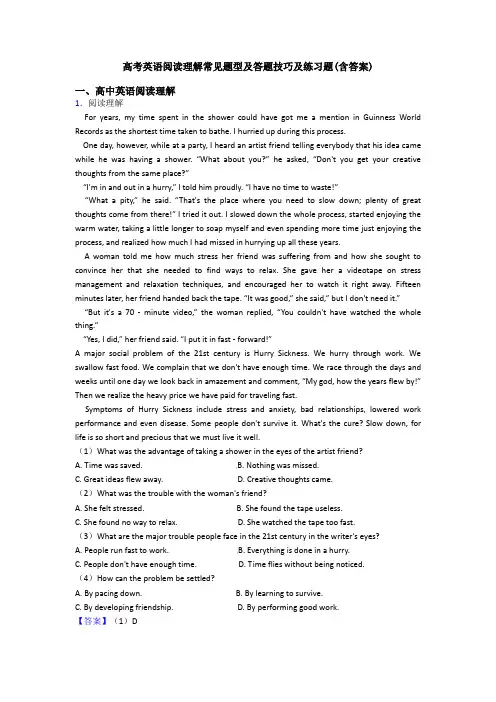
高考英语阅读理解常见题型及答题技巧及练习题(含答案)一、高中英语阅读理解1.阅读理解For years, my time spent in the shower could have got me a mention in Guinness World Records as the shortest time taken to bathe. I hurried up during this process.One day, however, while at a party, I heard an artist friend telling everybody that his idea came while he was having a shower. “What about you?” he asked, “Don't you get your creative thoughts from the same place?”“I'm in and out in a hurry,” I told him proudly. “I have no time to waste!”“What a pity,” he said. “That's the place where you need to slow down; plenty of great thoughts come from there!” I tried it out. I slowed down the whole process, started enjoying the warm water, taking a little longer to soap myself and even spending more time just enjoying the process, and realized how much I had missed in hurrying up all these years.A woman told me how much stress her friend was suffering from and how she sought to convince her that she needed to find ways to relax. She gave her a videotape on stress management and relaxation techniques, and encouraged her to watch it right away. Fifteen minutes later, her friend handed back the tape. “It was good,” she said,” but I don't need it.”“But it's a 70 - minute video,” the woman replied, “You couldn't have watched the whole thing.”“Yes, I did,” her friend said. “I put it in fast - forward!”A major social problem of the 21st century is Hurry Sickness. We hurry through work. We swallow fast food. We complain that we don't have enough time. We race through the days and weeks until one day we look back in amazement and comment, “My god, how the years flew by!” Then we realize the heavy price we have paid for traveling fast.Symptoms of Hurry Sickness include stress and anxiety, bad relationships, lowered work performance and even disease. Some people don't survive it. What's the cure? Slow down, for life is so short and precious that we must live it well.(1)What was the advantage of taking a shower in the eyes of the artist friend?A. Time was saved.B. Nothing was missed.C. Great ideas flew away.D. Creative thoughts came.(2)What was the trouble with the woman's friend?A. She felt stressed.B. She found the tape useless.C. She found no way to relax.D. She watched the tape too fast.(3)What are the major trouble people face in the 21st century in the writer's eyes?A. People run fast to work.B. Everything is done in a hurry.C. People don't have enough time.D. Time flies without being noticed.(4)How can the problem be settled?A. By pacing down.B. By learning to survive.C. By developing friendship.D. By performing good work.【答案】(1)D(2)A(3)B(4)A【解析】【分析】本文为应用文。
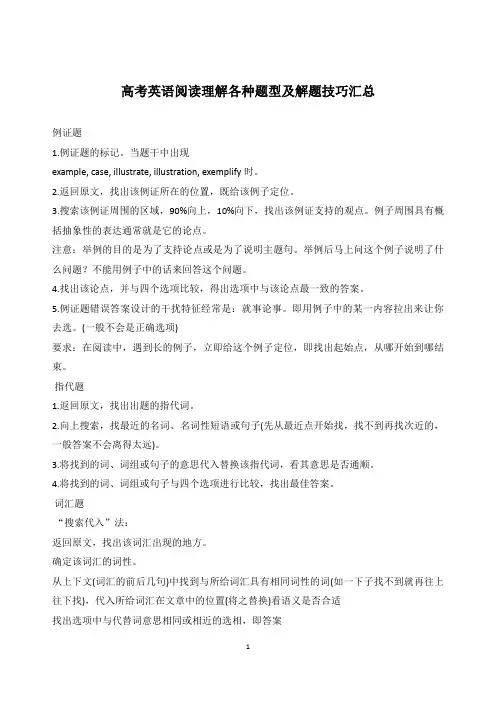
高考英语阅读理解各种题型及解题技巧汇总例证题1.例证题的标记。
当题干中出现example, case, illustrate, illustration, exemplify时。
2.返回原文,找出该例证所在的位置,既给该例子定位。
3.搜索该例证周围的区域,90%向上,10%向下,找出该例证支持的观点。
例子周围具有概括抽象性的表达通常就是它的论点。
注意:举例的目的是为了支持论点或是为了说明主题句。
举例后马上问这个例子说明了什么问题?不能用例子中的话来回答这个问题。
4.找出该论点,并与四个选项比较,得出选项中与该论点最一致的答案。
5.例证题错误答案设计的干扰特征经常是:就事论事。
即用例子中的某一内容拉出来让你去选。
(一般不会是正确选项)要求:在阅读中,遇到长的例子,立即给这个例子定位,即找出起始点,从哪开始到哪结束。
指代题1.返回原文,找出出题的指代词。
2.向上搜索,找最近的名词、名词性短语或句子(先从最近点开始找,找不到再找次近的,一般答案不会离得太远)。
3.将找到的词、词组或句子的意思代入替换该指代词,看其意思是否通顺。
4.将找到的词、词组或句子与四个选项进行比较,找出最佳答案。
词汇题“搜索代入”法:返回原文,找出该词汇出现的地方。
确定该词汇的词性。
从上下文(词汇的前后几句)中找到与所给词汇具有相同词性的词(如一下子找不到就再往上往下找),代入所给词汇在文章中的位置(将之替换)看语义是否合适找出选项中与代替词意思相同或相近的选相,即答案注意:a.如果该词汇是简单词汇,则其字面意思一般不是正确答案。
b.高考阅读不是考察字认识不认识,而是考察是否能根据上下文作出正确的判断。
c.词汇题的正确答案经常蕴藏在原文该词汇出现的附近。
注意不能靠单词词义直接往下推。
d.寻找时要注意同位语、特殊标点(比如分号,分号前后两句话的逻辑关系不是形式上的并列就是语义上的并列,也就是两句话的意思相同,所以可用其中一句话的意思来推测另一句话的意思从而推出所给词汇含义)、定语从句、前后缀,特别要注意寻找时的同性原则。
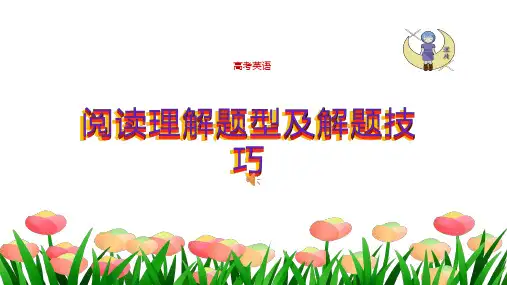
(英语)高考英语阅读理解常见题型及答题技巧及练习题(含答案)一、高中英语阅读理解1.阅读理解It was when I was walking to my office, trailed by three young people whose ages ranged from 16 to 25, flowing down the corridor behind me like the tail of a kite, that I thought of it for the first time.This could be because I am not actually a mother. Until recently, I was not a "real" stepmother either. But I have been living with the man who is now my husband, Bernardo for 10 years and in those 10 years, not only have his younger daughters spent every other weekend and half of their school holiday with us but also his son has lived with us full-time. In fact, when Bernardo asked me to move in, he asked his son for permission first.Being a step mum is hard enough but being a sort-of-step-mother is about the most awkward position a mature woman can find herself in. With my sort-of-steppies, I have occupied a place of influence, power and sometimes extreme anger by turns. I have stepped on a delicate path between being a grown-up friend, a bridge of influence with their father, the woman of the house, and a figure of authority – but not too much.Love the kids or hate them, you must always remember that no matter how much you cook, clean, hug, comfort and discipline, you will never actually count.To survive, I trained myself to love the stepkids as hard as I could, but not to care. It's a handy piece of good mental health trickery I recommend to anyone in my position. I can help with homework, yes, but not bother about the results of that homework. I can teach them good manners, but not care about the bad habits they learn at home. Semi-detached is the position.(1)Which of the following is true about Bernardo?A. Bernardo seldom cares about the kids.B. Bernardo dislikes living with his kids.C. Bernardo respects the opinion of his kids.D. Bernardo doesn't recognize his wife as a "real" stepmother.(2)What does the author think of her role in the family?A. She was totally favored by the kids.B. She has acted as an enemy of the kids.C. She didn't have any influence in the family.D. She was the communication bridge between kids and their father.(3)What's the author's advice for stepmothers in the last paragraph?A. Be partly engaged in kids' life.B. Care little about kids' behavior.C. Seldom get involved in kids' homework.D. Become the absolute authority of the family.【答案】(1)C(2)D(3)A【解析】【分析】本文是一篇说明文,介绍了作为一个继母应该如何与孩子相处才是一个适当的度。
高三英语阅读理解常见题型及答题技巧及练习题(含答案)及解析一、高中英语阅读理解1.阅读理解Nothing good generally comes of a conversation that start with the words, "I think you should probably sit down before I tell you this.”And so it came to pass. Away for Christmas, we got a call from kind friends at home, our neighbour's house had caught fire while they were out. The fire didn't spread to our house but the smoke very much did.It's weeks of either throwing out, or sending away for specialist cleaning, every single thing into which smoke could have permeated(渗透)because the particles(微粒) are an ongoing health risk and washing isn't enough. Anything soft—sofas and carpets and children's teddy bears, clothes—is suspected. We will be seeing in the New Year in a decidedly minimalist fashion.What I didn't expect to feel, however, is this lucky. Friends and neighbours have come together with incredible generosity. We will never again underestimate the closeness of the village community in which we live, or the innate kindness that is most people's natural reaction to trouble, and are grateful to be reminded of so much that is good. But that's not the only thing I've learned. For in a sense, we have a chance to start again.The surprise on being forced to think about what might urgently need replacing is how short the list of essentials seems; how much we must have been hanging on to out of habit, and how much we have been conditioned to think was important.It's all too easily assumed that family history lives in tangible(有形的)things— old photographs, a dress bought decades ago for a night heavy with memories — but that's not quite right. These things were only reminders of what we already carry with us in head and heart.Walking through the house, sweeping up the broken glass, I realised that the answer to the old question of "What would you save in a fire? " is actually that nothing really matters but each other.(1)What happened to the author's house?A.It caught a fire.B.It was affected by a fire.C.It was broken into by friends.D.Its windows were broken.(2)What does the underlined word "suspected" in Paragraph 3 refer to?A.something that may be damaged.B.something that may not be genuine.C.something that may not be so good.D.something that may be dangerous.(3)What did the author expect to feel?A.People around him were cold to others' trouble.B.His friends and neighbours were so generous.C.People in his community were close to each other.D.He was so lucky to find much that was good.(4)How will the author probably feel when the New Year finally comes?A.Worried.B.Surprised.C.Excited.D.Contented.【答案】(1)B(2)A(3)A(4)D【解析】【分析】本文是一篇记叙文,作者家房子受到火灾影响,物品受损,一切都需要清理,但朋友们和邻居们提供的帮助,让作者感受到了他们的善良,对他们感恩。
阅读理解5大题型解析一、细节理解题:定义:对原文的某事物、现象或理论等进行提问。
它们大多是根据文章中的具体信息如事实、例证、原因、过程、论述等进行提问的。
问题主要包询问人(who)、物(what)、时间(when)、地点(where)、原因(cause)、结果(effect) 以及文中的数据(data)等等。
特征:题干中包含有比较明确的具体信息,可以在原文中找到相对应的位置。
解题方法:定位法:根据题干信息回归原文找到相对应的位置(最好做划线记号),然后仔细分析划线部分前面或后面的句子,与选项做对比,与原文表述相一致的即为正确选项。
要特别注意的是,原文与选项对比是要表达意思一致,而不仅仅是某几个单词一样。
经典例题:(2010年福建高考英语卷C篇)Businesses are witnessing a difficult time, which has in turn produced influence on consumers’ desire to go green. However, shoppers are still laying stress on environmental concerns.Two thirds of customers say that environmental considerations inform their purchases to the same degree as they did a year ago, while more than a quarter say that they are now even better aware of the environmental effect on what they buy.This may help to influence how shops store goods on their shelves. And the companies should still make efforts to become more environmentally friendly. Two out of three people think it is important to buy from environmentally responsible companies, with about one in seven saying that they had even decided to take their custom elsewhere if they felt a company’s environmental reputation was not good enough.Harry Morrison, chief executive(主管)of the Carbon Trust, sympathizes: “I understand this situation where survival is very important now. But from environmental considerations, the clock is ticking—we don’t have much time. In addition, cutting carbon has an immediate effect as costs drop and a medium-term benefit for the brand.”Larger companies have an extra motivation to look at reducing their carbon footprint, as new rules next year will require businesses to buy carbon allowances to make up for their emissions (排放). Those that have taken early action will have a head start. More than two thirds of consumers are not clear about which companies are environmentally responsible. This suggests that firms that are able to relay clearly their message to the public will be in a pole position to attract shoppers.The Carbon Trust believes that it can help by informing customers about the good work companies are doing.“When companies are granted(授予)the standard, they can use a logo(标识)in all their marketing which makes it clear that they are working towards cutting emissions,” Mr. Morrison said.66.According to Harry Morrison, businesses .A. will benefit from cutting carbon emissionsB. should buy carbon allowances for shoppersC. are required to make up for their carbon emissionsD. have encouraged shoppers to take their custom elsewhere实战演练:(2010年福建高考英语卷E篇)In the United States, there were some well-constructed houses for native Indians, ranging from the simple brush shelter to the five-storied pueblo.In the eastern United States, one of the existing types was that commonly know under the Algonkian name of wigwam in which the Iroquois Indians lived. The wigwams were of wagon-top shape with straight sides and ends, made by bending young trees to form the round shape. Over this shape pieces of tree bark were laid to protect theIndians from bad weather. Over the bark dried grass was added. A small hole allowed smoke to escape from the top. Doorways at each en served also as windows, The Iroquois Indians built trunk walls all around their villages. The wall had only one opening. They could quickly close this opening if their enemies came near.Interestingly, the Choctaw Indians in Mississippi also lived in a wigwam of a most primitive(原始的) construction, but different from those of the Iroquois Indians. The Choctaw Indians’ wigwams, made from mud, cane and straw, were in the form of a bee-hive. The covering was made of a long, tough grass. A post in the centre supported the roof. A hole in the top admitted the light, and allowed the smoke to pass out.The tipi tent-housing of the upper lake and plains area was put up with poles set lightly in the ground, tied together near the top, and covered with bark and grass in the lake country. It was easily portable, and two women could set it up or take it down within an hour.The Pawnee, Mandan and other Indian tribes (部落) along the Missouri built solid ring-shaped structures of trunk, covered with earth and dried grass, housing a dozen families.The Wichita and other tribes of the Texas border built large ring-shaped houses covered with dried grass.Apart from the regular housing, almost every tribe had some style of housing.73. According to the passage, the Pawnee Indians built their houses _____.A. with openings in the trunk wallsB. large enough for several familiesC. in a ring shape with bark and mudD. by bending young trees to form the shape二、推理判断题:定义:在理解原文表面文字信息的基础上,根据文章的信息做出一定判断和推论,从而得到文章的隐含意义和深层意义。
高考英语阅读理解主要有以下几种题型:
1.细节理解题:要求考生根据文章提供的信息,回答关于时间、地
点、人物、事件等方面的问题。
2.推理判断题:要求考生根据文章的内容和逻辑关系,进行推理和
判断,回答关于作者的态度、观点、意图等问题。
3.主旨大意题:要求考生概括文章的主题或中心思想。
4.猜测词义题:要求考生根据上下文猜测单词或短语的含义。
5.指代关系题:要求考生理解文中代词或其他词语所指代的内容。
针对这些题型,以下是一些解题技巧:
1.快速浏览文章:在阅读理解考试中,时间通常比较紧张,因此快
速浏览文章是非常重要的。
可以先阅读文章的标题、开头和结尾,以及每段的首句和尾句,了解文章的大致内容和结构。
2.注意关键词:在阅读文章时,可以注意一些关键词,如人名、地
名、时间、数字、连词等,这些关键词可以帮助理解文章的内容和逻辑关系。
3.理解文章的主旨大意:在阅读文章时,要注意理解文章的主旨大
意,这可以帮助回答主旨大意题和推理判断题。
4.猜测词义:在遇到不认识的单词或短语时,可以根据上下文猜测
词义。
5.注意细节:在回答细节理解题时,要注意文章中的细节信息,如
时间、地点、人物、事件等。
6.排除干扰项:在回答问题时,要注意排除干扰项,选择最符合文
章内容和逻辑关系的答案。
英语阅读各题型及解法汇总英语考的好不好看阅读理解错几个就知道了阅读理解如何快速提升这几个秘诀帮你助攻↓一、阅读理解的题型设置要想做好阅读理解题,首先要对阅读理解的题型设置非常熟悉。
阅读理解的题型归纳起来无外乎以下几种。
1.猜测词义常见设题方式为:What does the underlined word/phrase inPara. X probably means according to the passage?What does the bold word in the passage refer to?etc.2.归纳大意和逻辑推理常见设题方式为:(1)What’s the main idea of the passage?(2)What can we learn from the passage?(3)What can we infer from the passage?3.确定标题常见设题方式为:(1)Which of the following can act as the title of thisp assage?(2)What’s the best title of the passage?4.正误判断常见设题方式为:(1)Which of the following statements is True/Falseaccordingto the passage?(2)which of the following statements is(not)mentioned in thepassage?5.事件排序常见设题方式为:(1)Which is the right order of the events mentioned in thepassage?6.作者意图或态度常见设题方式为:(1)What’s the author’s/writer’s attitude towards somethingaccording to the passage?(2)What does the author want to tell us?二、根据题型找到方法1.例证题①例证题的标记。
英语阅读各题型及解法汇总
英语考的好不好
看阅读理解错几个就知道了
阅读理解如何快速提升
这几个秘诀帮你助攻↓
一、阅读理解的题型设置
要想做好阅读理解题,首先要对阅读理解的题型设置非常熟悉。
阅读理解的题型归纳起来无外乎以下几种。
1.猜测词义常见设题方式为:What does the underlined word/phrase inPara. X probably means according to the passage?What does the bold word in the passage refer to?etc.
2.归纳大意和逻辑推理常见设题方式为:(1)What’s the main idea of the passage?(2)What can we learn from the passage?(3)What can we infer from the passage?
3.确定标题常见设题方式为:(1)Which of the following can act as the title of this passage?(2)What’s the best tit le of the passage?
4.正误判断常见设题方式为:(1)Which of the following statements is True/False accordingto the passage?(2)which of the following statements is(not)mentioned in thepassage?
5.事件排序常见设题方式为:(1)Which is the right order of the events mentioned in thepassage?
6.作者意图或态度常见设题方式为:(1)What’s the author’s/writer’s attitude towards somethingaccording to the passage?(2)What does the author want to tell us?
二、根据题型找到方法
1.例证题
①例证题的标记。
当题干中出现example,case,illustrate,illustration,exemplify时。
②返回原文,找出该例证所在的位置,既给该例子定位。
③搜索该例证周围的区域,90%向上,10%向下,找出该例证支持的观点。
例子周围具有概括抽象性的表达通常就是它的论点。
注意:举例的目的是为了支持论点或是为了说明主题句。
举例后马上问这个例子说明了什么问题?不能用例子中的话来回答这个问题。
④找出该论点,并与四个选项比较,得出选项中与该论点最一致的答案。
⑤例证题错误答案设计的干扰特征经常是:就事论事。
即用例子中的某一容拉出来让你去选。
(╳)
要求:在阅读中,遇到长的例子,立即给这个例子定位,即找出起始点,从哪开始到哪结束。
2.指代题
①返回原文,找出出题的指代词。
②向上搜索,找最近的名词、名词性短语或句子(先从最近点开始找,找不到再找次近的,一般答案不会离得太远)。
③将找到的词、词组或句子的意思代入替换该指代词,看其意思是否通顺。
④将找到的词、词组或句子与四个选项进行比较,找出最佳答案。
3.词汇题:“搜索代入”法
①返回原文,找出该词汇出现的地方。
②确定该词汇的词性
③从上下文(词汇的前后几句)中找到与所给词汇具有相同词性的词(如一下子找不到就再往上往下找),代入所给词汇在文章中的位置(将之替换)看语义是否合适
④找出选项中与代替词意思相同或相近的选相,即答案
注意:
a.如果该词汇是简单词汇,则其字面意思必然不是正确答案。
b.高考阅读不是考察字认识不认识,而是考察是否能根据上下文作出正确的判断。
c.词汇题的正确答案经常蕴藏在原文该词汇出现的附近。
注意不能靠单词词义直接往下推。
d.寻找时要注意同位语、特殊标点(比如分号,分号前后两句话的逻辑关系不是形式上的并列就是语义上的并列,也就是两句话的意思相同,所以可用其中一句话的意思来推测另一句话的意思从而推出所给词汇含义)、定语从句、前后缀,特别要注意寻找时的同性原则。
比如:让猜一个名词词组(动词词组)的意思,我们就向上向下搜索名词词组(动词词组)。
▲隐蔽型词汇题:题干与原文的某句完全重合,只有一两个词被替换掉。
隐蔽型词汇题的做法跟词汇题的做法几乎一样,往上往下找。
4.句子理解题
①返回原文找到原句。
②对原句进行语法和词义的精确分析(找主干),应该重点抓原句的字面含义。
若该句的字面含义不能确定,则依据上下文进行判断。
注意:局部含义是由整体决定的。
③一般来说,选项中的正确答案与原句意思完全相同,只不过用其他英语词汇换种表达而已。
④句子理解题的错误选项干扰项特征:推得过远。
做题时应把握住推的度。
思路:对句子微观分析?不行就依据上下文?选择时不要推得过远。
5.推理题:“最近原则”
①标志:learn,infer,imply,inform
②看是否可以通过题干返回原文或依据选项返回原文。
一般要围绕文中的一两个重点进行推理。
推理题无论通过题干能不能定位,我们都要把它固化到文章的一两点上。
③依据原文的意思进行三错一对的判断。
先不要进行推理,若有一个选项跟原文的意思一模一样,则该选项必然是正确答案。
推理题不是考察我们的想象力,它实际是考察我们原文中的某几个点如一个、两个点所涉及的问题我们读透了没有。
因此,不推的比推的好;推的近的比推的远的要好。
④推理题的最近答案原则:不推的要比推的好,推的近的要比推的远的好,直接推出的要比间接推的好。
(原文的某句话变个说法)
注意:做题时不能想得太多,推得过远。
是否把原文读懂才是关键。
6.主旨题:“串线摘帽”
即在自然段少的时候串串线,串线法解不出来时,大帽子、小帽子摘一下。
①主旨题的标志:mainlyabout,mainlydiscuss,thebesttitle
②串线法:抓首段和其余各段的第一句话,把其意思连接成一个整体。
要注意总结性的提示词和转折词,特别要注意中心句。
(主要针对自然段少的文章;针对自然段多的文章,主旨题最好联系中心句。
找一个和中心句最贴近的)
③小心首段陷阱。
④主旨题错误选项的干扰特征经常是:
⑴局部信息,即选项的容小于文章的容;
⑵围过宽,即选项的容大于文章的容。
⑤逆向思维法、快速作文法:在两个选项看上去都十分正确无法选择时,试着从选项出发,想象一下如果自己以此选项来写文章会有那些容,然后把它与文章的容比较,接近的即为正确选项。
7.作者态度题
①标志:attitude
②应精确理解四个选项的含义。
③不要掺杂自己的观点。
④可以寻找文中一些具有感情色彩的词。
如:fortunately,excessively,toomany.
⑤举例的方式。
⑥抓论述的主线。
把第一段读透,把其他各段的段首段尾句拉出来,看整个文章的谋篇结构。
⑦做作者态度题时特别注意:首先看清楚是谁对谁的态度。
8.判断题
①看可否通过四个选项具体化到文中一点或者根据自然段原则定位。
②每个选项都应返回原文,不能凭主观印象进行判断。
③要重点抓是“三错一对”还是“三对一错”的关系(做题是要看清题目)。
9.细节题
看完题目回到原文,重叠原文,得出答案
10.重点题型中的几个问题
①词汇题:字面意思不是答案,要根据上下文推测其深刻含义
②句子理解题:一般不要求推理,只看句子本身。
③推理题:答案很大程度上是原文的重现,不一定非要经过逻辑推理从原文中得出。
11.正确答案的特征
①正确答案经常与中心思想有关。
②正确答案的位置,最常见的三个位置是:段首段尾处、转折处、因果处。
③正确答案经常运用的原则是:同义替换、正话反说、反话正说。
④从语气角度来看,正确答案中经常含有不肯定的语气词和委婉表达的用词。
如:can,may,might,possible,notnecessarily,some.
⑤正确答案经常具有概括性、深刻性,不能只见树木不见森林。
12.错误答案的特征
第一大层次:
①无中生有(未提及的概念);
②正反混淆(选项的意思跟原文的意思正好相反);
③所答非所问(虽然选项的说法没有问题,符合原文,但和题干搭不上边)
第二大层次:
①过分绝对;
②扩大围(注意隐蔽型的扩大围mostly);
③因果倒置;
④常识判断;
⑤推得过远;
⑥偏离中心;
⑦变换词性。